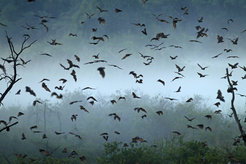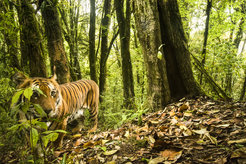Building an internet to help animals
Powered by online databases and AI, the Internet of Animals is a new model for understanding and managing life on the planet
In the two decades since it became widely adopted, the internet has rewired human society—from how we work, to where we shop, to the ideologies we live by. Now, the internet is on the cusp of revolutionizing the world for non-human animals too, according to a review published by two scientists from the Max Planck institute of Animal Behavior (MPI-AB) and NC State University.

The paper describes how a confluence of developments in tech and artificial intelligence, which the authors call the “Internet of Animals”, is giving us the power to make predictions about the natural world. This predictive power, they say, offers a means to mitigate modern scourges like climate change, biodiversity loss, and disease. By predicting the behavior of animals, we can intervene with management solutions to help them—and, ultimately, ourselves.
“Imagine the combined knowledge of animals being gathered online, where it is linked and analyzed to produce real-time results and predictions about the most important issues of our time,” says Martin Wikelski, a director of the Department Migration at MPI-AB and senior author of the review.
“That’s the internet of animals, and it’s already taking shape. We think that with further development, the concept can meet its future potential of helping humans and animals to coexist.”
But realizing this potential requires solving challenges. In the review, Wikelski and first author Roland Kays, from NC State University, describe the internet of animals in its present form and lay out a vision for its future.
What it is, what it could be
The field of animal ecology has entered the era of big data and the Internet of Things. Unprecedented amounts of data are being collected on wildlife populations, thanks to technology such as satellites, drones, automatic cameras, and sensors placed on animals or in their surroundings.
In addition, vast troves of information on animals exist from museum collections; citizen science observations collected through websites like iNaturalist; records of diseases; veterinarian records; and conservation lists, among many others.
These data are being streamed into databases where they are made available online, and increasingly connected to each other. Today, they can be analysed by a growing number of AI programs that make sense of the numbers. Many of these AI-based tools, such as plant and animal identification apps iNaturalist and PictureThis, are widely available.

This confluence of factors has led to the emergence of the Internet of Animals (IoA): “All these different databases have a connection between them, and some analysis engine to combine them into actionable information,” says Roland Kays, a professor at NC State University and head of the Biodiversity Research Lab at the North Carolina Museum of Natural Sciences.
For the authors, projects with real-time conservation action represent the best examples of how the IoA is helping animals right now. There’s the example of BirdCast, which uses multiple data sources every day to forecast when birds are migrating overhead. “Cities are starting to turn out the lights to protect those birds during that part of the year,” says Kays.
Or the example of Whale Safe, which combines live data from acoustic monitoring and human observation of whales on the California coast to generate advice for when ships should reduce their speed to avoid collisions.
These examples, the authors say, are just the beginning of what’s possible.
A full-fledged IoA could enable us to predict animals’ future in a changing climate—where their new habitats would be, and if they need help to get there. It could map the spread of animal diseases in real time and reveal new hosts of zoonotic viruses. It could be used to reduce the impact of domesticated animals on wildlife—smart collars on cats detecting hunting behavior and triggering an action to prevent it.
Millions of commercial products are already collecting sensor data about the environment. The future IoA could harness these products to monitor nature at the same time—millions of smart cars driving on roads around the world while counting insects as part of a standardized protocol linked into the IoA, for example.
“There’s so much information being collected about animals today—on purpose or by accident,” says Kays. “We need an efficient, AI-powered internet of animals to help make sense of it, and use it for conservation.”
The IoA of today offers a glimpse into this future. Wikelski and Kays end the review by outlining the steps that must be taken to get there. These include overcoming hurdles like how to integrate different types of data; how to link data when taxonomy is in constant flux; and how to give credit to those who collect and share data.
The result could be a way of forecasting life on the planet.
Says Wikelski: “Before, the pieces of knowledge we had about animals were so far apart that we couldn’t predict ecological phenomena. You could liken it to a farmer’s tale that low flying swallows mean changing weather.
“Now, we have bird movement data linked to remote sensing, cloud development, and insect abundance, all analyzed with sophisticated tools. This real-time connection of disparate pieces of information allows us to identify cause and effect, and to ultimately make predictions about natural phenomena that we previously didn’t understand.”













